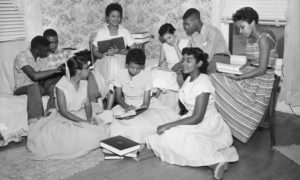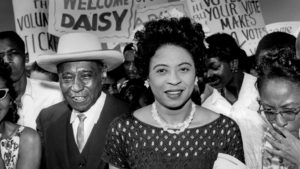Ringside Report Looks Back at Daisy Bates and the Little Rock Nine
[AdSense-A]
Brave. Strong. A woman of valor. That was civil rights activist Daisy Bates. She would not let her background stop her from making a mark on the civil rights movement. The child who was left in the care of family friends would go on to become a journalist, lecturer, powerful civil rights activist, and would mentor the first group of black students to integrate Central High School in Little Rock, Arkansas. September 25, 2020 is the 63rd anniversary of the first day of school for the Little Rock Nine.
Born Daisy Gaston on November 11, 1914 in Huttig, Arkansas, she would be adopted as an infant after her mother was raped and murdered by three white men. Her father would leave her to be raised by family friends. As a child, Daisy Gaston attended segregated schools where she used old textbooks and learned firsthand the conditions black children were educated in. Daisy met Lucius Christopher Bates when she was a teenager. Two married in 1942 and moved to Little Rock, Arkansas.
Together, Lucius and Daisy Bates ran a weekly newspaper, the Arkansas State Press, which focused on civil rights issues moving them to the forefront from 1942 until 1959 when boycotts of the paper by local advertisers would lead to its closure. In 1952, Daisy Bates became president of the Arkansas branch of the NAACP. After the Supreme Court ruled that the segregation of schools was unconstitutional in 1954, Mrs. Bates would use her position to promote the integration of schools in Little Rock, Arkansas. She led protests to get the school board to move forward with integrating public schools.
In 1957, seventy-five black students registered at the all-white Central High School in Little Rock. Out of the seventy-five students, nine were chosen to be the first to integrate the school in the upcoming school year. The students who were called the Little Rock Nine were: 16 year-old Minnijean Brown, 15 year-old Elizabeth Eckford, 16 year-old Ernest Green, 16 year-old Thelma Mothershed, 15 year-old Melba Patillo, 15 year-old Gloria Ray, 15 year-old Terrence Roberts, 15 year-old Jefferson Thomas, and 14 year-old Carlotta Walls. The students were recruited by Daisy Bates and members of the NAACP.
Prior to the start of the school year, the students learned about what they should expect and how to respond in the wake of great hostility. Daisy Bates drove eight of the nine students to the Central High School on the first day of classes, September 4, 1957. Elizabeth Eckford was the first black student to arrive for the first day of classes alone. Her family did not own a phone, and Daisy Bates did not have a way to contact her about the carpool. With notebook in hand, Ms. Eckford walked towards the school as a crowd of angry white students and adults screamed at her. One woman even spat on her.
The National Guard was sent to the Central High School by Governor Orval Faubus, to keep the Little Rock Nine from entering the school. Governor Faubus claimed that he was worried violence might break out if the students were allowed to attend the school. But a federal judge  ordered the National Guard removed by September 20th and the Little Rock Police Department was sent to take over the accompaniment of the Little Rock Nine. But, when the group proceeded to attend school on September 23, 1957, at least 1,000 angry white protestors were outside the school. The police decided to remove the black students to deter rioting from the angry mob. President Eisenhower sent members of the US Army to the school, and the Little Rock Nine was able to attend classes for the first time on September 25, 1957.
ordered the National Guard removed by September 20th and the Little Rock Police Department was sent to take over the accompaniment of the Little Rock Nine. But, when the group proceeded to attend school on September 23, 1957, at least 1,000 angry white protestors were outside the school. The police decided to remove the black students to deter rioting from the angry mob. President Eisenhower sent members of the US Army to the school, and the Little Rock Nine was able to attend classes for the first time on September 25, 1957.
Daisy Bates and her husband used their home as the central location for the students to travel to and from the Central High School, and they supported the students through the hostility they faced. Several students experienced harassment while attending the school. Melba Patillo was kicked and acid was thrown in her face. Elizabeth Eckford was pushed down a flight of stairs. Minnijean Brown was expelled for calling a group of white girls “white trash” after they had attacked her. And Gloria Ray’s mother lost her job after she would not remove her daughter from the school. And none of the black students were allowed to participate in extracurricular activities. Daisy and Lucius Bates experienced violent attacks also, as their house was often targeted by angry white people who wanted segregation to remain.
The following year in September 1958, Governor Faubus decided to close all of the high schools in Little Rock and hold a vote in hopes of preventing further integration of the schools. The citizens of Little Rocked voted in favor of keeping the high schools segregated, and the high schools remained closed for one year. They reopened in August of 1959. While some of the Little Rock Nine went on to graduate at other schools and by other means, four of the black students would go on to graduate from the school.
Sadly, Little Rock, Arkansas still faces issues around segregation of its schools to this day. After the state had taken over control of Little Rock’s public school system, in 2019, the governor-appointed State Board of Education came up with a new plan. The best schools in Little Rock which are in the northern and western parts of the city, and have high enrollments of white students, would be run by a locally elected school board. The worst schools in Little Rock, located in the southern and eastern parts of the city, which also have high enrollments of black and Latino students, would be run by state officials. Only one part of the community, the part that is primarily white, would have a say over its schools, and the other part of the community, the part with mostly people of color, would not.
1962, Daisy Bates would release an autobiography about her role in the fight against segregation and her account of the Little Rock Nine titled, “The Long Shadow of Little Rock”. She would be the only woman to speak at the March on Washington in 1963. Lucius and Daisy Bates would later move to Washington, DC where she would go on to work for the Democratic National Committee until she suffered a stroke in 1965. In 1968, the Bates moved back to Arkansas. After Lucius Bates died in 1980, Daisy Bates re-started the State Press newspaper in 1984. Daisy Bates died of a heart attack on November 4, 1999 at the age of 84 and was laid to rest at the Haven of Rest Cemetery in Little Rock, Arkansas.
She has been honored in several ways both before and after her death. In 1957, Daisy Bates she named woman of the year by the National Council of Negro Women. In 1984, she received an honorary Doctor of Laws degree from the University of Arkansas at Fayette. In 1987, the Daisy Bates Elementary School was opened in Little Rock, Arkansas. And in November 1999 after her death, President Bill Clinton awarded her and the members of the Little Rock Nine with the Congressional Gold Medal.
[si-contact-form form=’2′]


